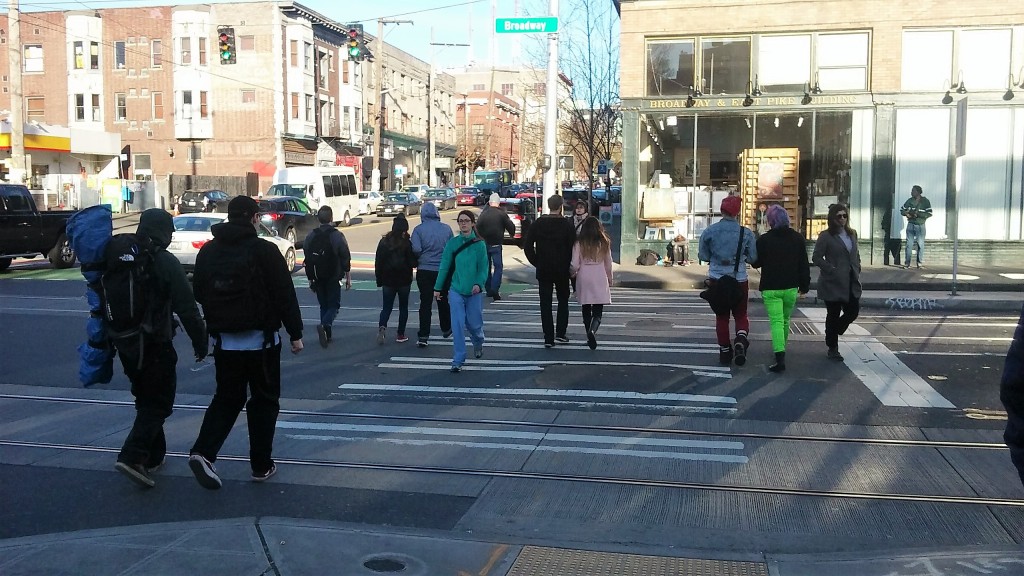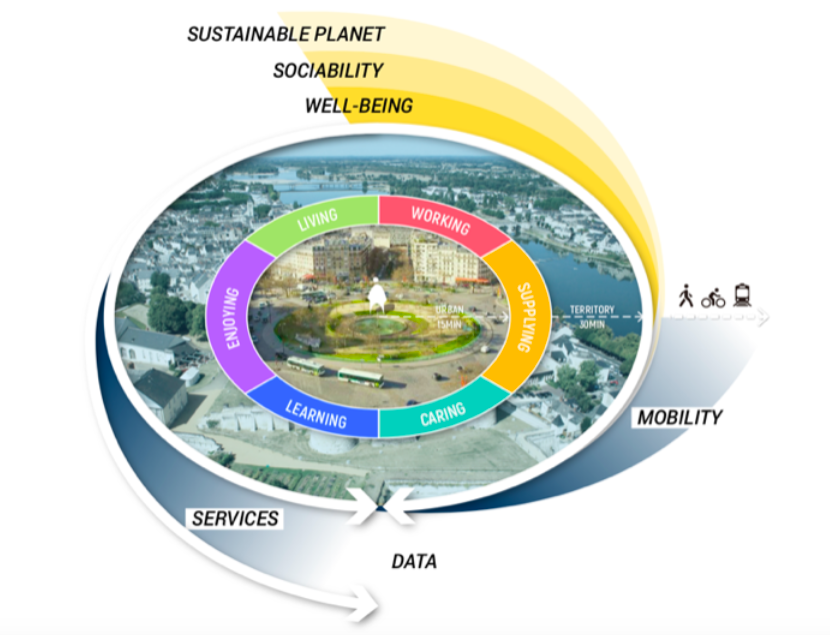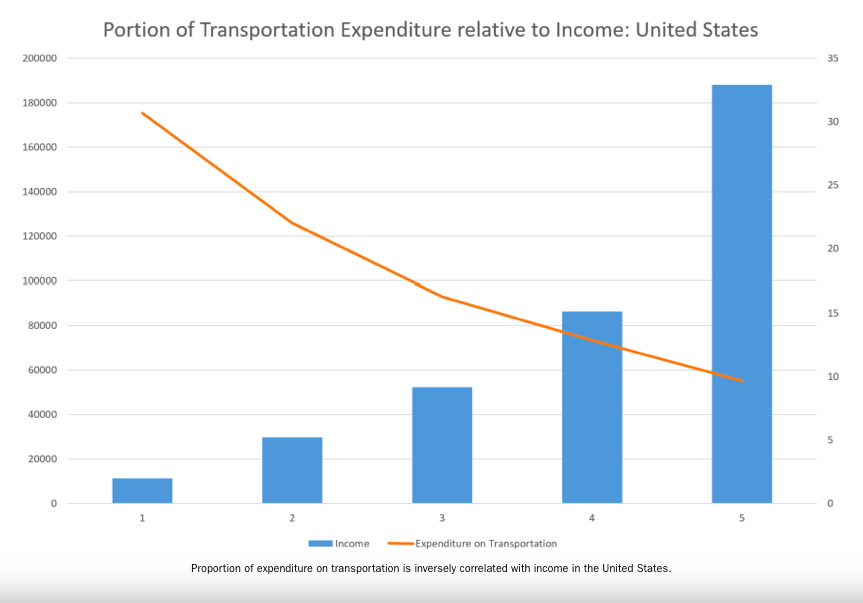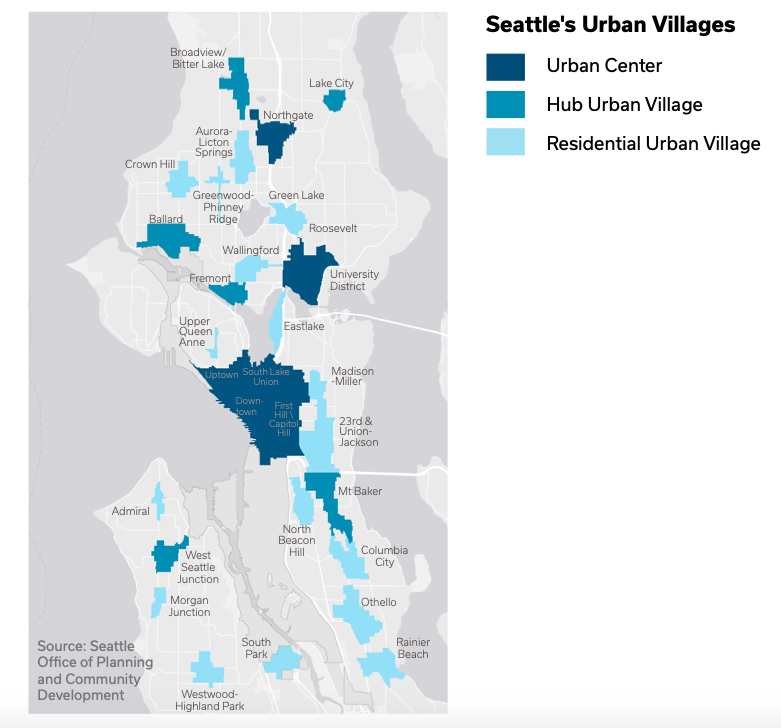
Seattle’s quirky and individualistic neighborhoods are one my favorite features of the city. I love the fact that an afternoon spent hanging out in Capitol Hill has a different feeling than one spent in the University District, Columbia City, or Alki Beach. Over the years, I have clocked more satisfying vacation time exploring or relaxing in Seattle’s neighborhoods than anywhere else on the globe, and I often joke to my husband that the easiest (and cheapest) way for me to experience a complete vacation is to travel to Madison Park Beach, only a couple of miles away from where I live as the crow flies.
But despite the charms they may offer, many of Seattle’s neighborhoods fail on an important point: residents have to travel outside of their neighborhoods’ boundaries to meet essential needs related to work, education, shops, healthcare, entertainment, and access to healthy groceries.
The Covid epidemic has forced us to consider the built environment and transportation systems that shape our daily lives in new ways, and one side effect of our altered reality is a growing amount of fanfare around the concept of the 15-minute city, which proposes that all city residents should be able to meet their essential needs within a short walk or bike ride of home.
Last week while discussing proposed amendments to Seattle’s comprehensive plan, Seattle 2035, which serves as a 20-year vision and roadmap for Seattle’s future, the Office of Planning and Community Development (OPCD) shared that they will be exploring the concept of a “15-minute city” as a potential framework for the next major Comprehensive Plan update due in 2024, thus potentially adding Seattle’s name to the growing list of cities vying for the distinction.
A bit more about the 15-minute city
The concept of the 15-minute city appears to be simple, but its creator has more ambitious plans for urban transformation than its name would suggest. First coined by Professor Carlos Moreno, scientific director of entrepreneurship and innovation at the Sorbonne and special envoy to Paris Mayor Anne Hidalgo, the 15-minute city is part of Moreno’s philosophy of “chrono-urbanism,” or an urbanism that prioritizes planning efforts around how urban residents spend their time.
Formulated in the reaction to the climate crisis, Moreno’s chrono-urbanism takes the stance that eliminating our reliance on fossil fuels requires major lifestyle changes, namely slowing down the pace of life in cities. Chrono-urbanism also espouses that a transition to a slower pace would improve residents’ well-being.

“Living differently means above all changing our relationship with time, essentially time relating to mobility, which has greatly degraded the quality of life due to commuting which is costly in every respect,” writes Moreno in The 15 minute city: for a new chrono-urbanism. He goes on to explain that a transition needs to be made from “city planning to urban life planning,” which he describes as planning undertaken with the goal of transforming cities from centralized and zoned for different uses–a.k.a. mono-functional–to a “polycentric city” in which multi-use spaces are the norm, thus creating an urban system in which all residents can meet all their essential needs within a brief walk or bike ride.
A concrete example of a multi-use space in Moreno’s 15-minute city is a public school building, which would be used for cultural and civic events and programming during evenings, weekends, and periods when school is not in session.
The centrality of community life and social interaction in Moreno’s philosophy is often lost in conversations about the 15-minute city taking place in our current socially distant world. Rather than presenting destinations, like shops or workplaces, as essential to access within short distance of home, Moreno’s work focuses on six essential urban social functions which he describes as living, working, supplying, caring, learning, and enjoying.
Fostering biodiversity through integration of greenery into daily life, leveraging digital technologies to create real social connection, and providing access to public services that meet people’s needs are also essential to the success of the 15-minute city in his perspective.
How could the 15-minute city help a Covid economic recovery?
The C40 Cities, of which Seattle is a member, present a slightly different take on the 15-minute city, promoting it as a model for increasing equity and inclusivity in cities. In general, the concept of the 15-minute city seems to be evolving beyond Moreno’s initial presentation as it adapts in response to localized urban needs. In the C40 Mayors’ Agenda for a Green and Just Recovery the 15-minute city is highlighted as a key strategy for taking action to promote city dwellers’ health and well-being during the Covid recovery, connecting it to other municipal actions like permanently reallocating road space for walking and cycling and increasing investments in active transportation and green infrastructure.
The primary goal for the C40 Cities’ Covid recovery is to not return to business as usual. Instead, the mayors pledge to use the recovery as a catalyst for social change, civic improvement, and greater environmental sustainability. Seattle Mayor Jenny Durkan has signed onto the C40 Mayors’ Agenda along with mayors from cities across the world, including many large cities with diverse urban challenges like New York City, London, Delhi, and Hong Kong. According to its press release, the group of mayors has established a taskforce currently researching strategies to achieve the “necessary transition to a more sustainable, low-carbon, inclusive and healthier economy for people and the planet.”
In the Bloomberg CityLab article, How the ’15 minute City’ Could Help Post-Pandemic Recovery, Patrick Sisson describes some of the economic benefits that could result from a transition to a 15-minute city model. Dario Hidalgo, senior mobility researcher for the World Resource Institute’s Ross Center for Sustainable Cities, said creating opportunities to people to travel by walking and cycling not only decreases carbon emissions–these activities also set the stage for creating new opportunities for small businesses to thrive. Helping the local economy is one of the reasons why Montreal mayor Valérie Plante opted to open up 186 miles of streets for pedestrians and cyclists this summer. “We want to encourage people to buy local, and forget Amazon,” she said at a press conference.
Switching to a 15-minute city could also bring cost savings to residents. Sisson interviewed Lord Mayor Sally Capp of Melbourne, Australia, a member the C40 task force, who related how sprawl has allowed for the creation of affordable housing in the Melbourne metro area, but unfortunately has also led to a rise in “unaffordable living.” In a 15-minute city, however, people would spend less time and money on transportation. Such a change would reap benefits for people of all economic means, but in the United States, its greatest benefits would be felt by the lowest income Americans who on average spend nearly 30% of their monthly household expenses on transportation.

Avoiding the “islands of walkability” approach
One of the pitfalls that urban planning experts believe could befall American cities–like Seattle–as they move toward the 15-minute city model is a failure to create a truly complete neighborhoods that connect across the city. In the same Bloomberg CityLab article, Sisson shares examples of how the challenges of converting existing suburban sprawl can led to even the best planned new developments ending up as “islands of walkability in a sea of cars.”
“Drive, park, and enjoy being a pedestrian momentarily; that’s what you do at Walt Disney resorts. That’s not what you’re supposed to do in cities,” said Dario Hildago, describing a common experience in many American cities.
Seattle’s urban village strategy for growth has led to many parts of the city embodying the urban design pattern of centralized neighborhood hubs surrounded by expanses of single-family residences. A prime example of this pattern is the affluent, almost entirely single family residence zoned, neighborhood of Magnolia, which stands out among Seattle neighborhood’s for having no urban village designation. Magnolia’s small commercial area is located near amenities like a public park and elementary school, and it is designed to be walkable and accessible by transit. Yet Magnolia’s commercial area stands out as an “island of walkability” because so many residents opt to drive to it because there is little dense housing nearby. Separation from other Seattle neighborhoods by both a geographic barrier, the Lake Washington Ship Canal, and a human made barrier, the Interbay Armory presents additional hurdles for active transportation planning. Transforming Magnolia into a 15-minute neighborhood would require adding denser housing and additional commercial areas, both of which are generally not allowed in current lands codes; connecting Magnolia into fully functioning into a Moreno styled polycentric 15-minute city would require more changes still.

In Neighborhoods for All and Evolving Seattle’s Growth Strategy, Seattle Planning Commission (SPC), an appointed advisory board, argues that to increase affordability while lessening dependence on fossil fuel based transportation, the city needs to investigate increasing the size of urban villages and adding new urban villages to its roster. SPC also shares the concept of an urban hamlet, which would be a new type of urban village that would provide “moderate increases in housing density around existing commercial nodes, or close to schools and parks.” Magnolia is identified as an area that might support urban hamlets, as are Delridge, Leschi, Madison Park, Madrona, Montlake, Seward Park, South Beacon Hill, Tangletown, Wedgwood, and Sand Point.
Transforming Seattle into a 15-minute city presents many challenges; however, existing resources like Neighborhoods for All provide a framework for moving forward. Seattleites have a right to be proud of their distinctive neighborhoods, but they also have a right to meet their essential needs in less time and with less reliance on fossil fuels. With its steep hills and large bodies of water, Seattle will never fit neatly into the type of 15-minute city Paris is becoming under Mayor Hildago’s leadership; however, with some creative thinking and commitment to changing the zoning status quo, it might one day create its own chrono-urbanist future.
Natalie Bicknell Argerious (she/her) is a reporter and podcast host at The Urbanist. She previously served as managing editor. A passionate urban explorer since childhood, she loves learning how to make cities more inclusive, vibrant, and environmentally resilient. You can often find her wandering around Seattle's Central District and Capitol Hill with her dogs and cat. Email her at natalie [at] theurbanist [dot] org.

